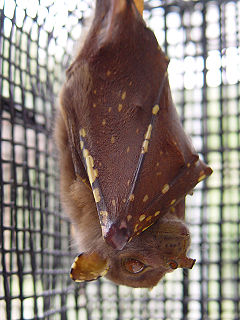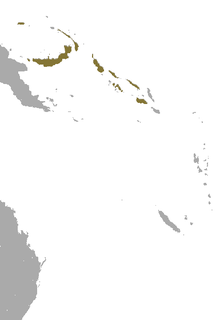
Megabats constitute the family Pteropodidae of the order Chiroptera (bats). They are also called fruit bats, Old World fruit bats, or—especially the genera Acerodon and Pteropus—flying foxes. They are the only member of the superfamily Pteropodoidea, which is one of two superfamilies in the suborder Yinpterochiroptera. Internal divisions of Pteropodidae have varied since subfamilies were first proposed in 1917. From three subfamilies in the 1917 classification, six are now recognized, along with various tribes. As of 2018, 197 species of megabat had been described.

The eastern or Queensland tube-nosed bat is a megabat in the family Pteropodidae that lives in north-eastern Australia. N. robinsoni is one of the few species in Pteropodidae that roosts solitarily. They get their common name from their raised tubular nostrils which is unlike most other species in the family. They are a deep brown with gray heads and sparse yellow spotting.

The black-bellied fruit bat is a species of order Chiroptera in the family Pteropodidae.

The common tube-nosed fruit bat is a species of megabat in the family Pteropodidae. It is found at islands north of Australia, and in Indonesia, Papua New Guinea, the Philippines and the Solomon Islands.

The round-eared tube-nosed fruit bat is a species of bat in the family Pteropodidae. It is possibly conspecific with Nyctimene certans, although the taxonomy remains unresolved. The possible synonymy of the species was investigated by Randolph L. Peterson in 1991, finding the species split into two distinct groups based on morphology. It is found in West Papua and Mansuar Island in Indonesia.

The dragon tube-nosed fruit bat is a species of bat in the family Pteropodidae. It is found on both sides of New Guinea: West Papua, Indonesia and Papua New Guinea. It is slightly smaller and very similar in appearance to N. albiventer, differing by having more profuse, dark spotting on its wing membranes, and smaller shorter canines. The similarity between the species has been a source of possible misidentifications. The records of this species from Papua New Guinea are associated with freshwater swamps and rivers.

The lesser tube-nosed bat is a species of megabat in the family Pteropodidae. It is native to two of the Maluku Islands in northern Indonesia.

The Umboi tube-nosed fruit bat is a species of megabat in the family Pteropodidae. It is found in Papua New Guinea and the Solomon Islands.

The lesser tube-nosed fruit bat or unstriped tube-nosed bat is a species of megabat in the family Pteropodidae found in West Papua, Indonesia and Papua New Guinea.

The gray flying fox is a species of flying fox in the family Pteropodidae. It is not to be confused with the grey flying fox. It is found in Indonesia, but not in the Philippines, despite occasional reference to such. Very little is known about this species. The gray flying fox has small size and neutral coloration with a brownish head and an orange abdomen. It probably roosts individually or in small groups. It was listed on appendix II of CITES, and is classified as "Data Deficient" by the IUCN. This species has been decimated by hunting for bushmeat in Indonesia. The hunters use fishing hooks, ropes, and other supplies to hunt the bats. The ropes and hooks are placed along their flight paths, tearing and ensnaring the bats' wings when are flying. In the course of a hunting season, entire colonies can be killed.

The Aru flying fox is a Critically Endangered species of megabat found in the Aru Islands in Indonesia. It was described by Wilhelm Peters in 1867. It was formerly considered a subspecies of the black-bearded flying fox. The species is poorly known, and has not been encountered since the 19th century. It is classified as critically endangered by the IUCN and is listed on CITES appendix II.

Nyctimene is a genus of bats in the Pteropodidae family. Commonly known as tube-nosed fruit bats, they are found in the central Philippines, eastern Indonesia, Papua New Guinea and the north-east coast of Australia.

Keast's tube-nosed fruit bat is a species of megabat in the family Pteropodidae found in Babar, Tanimbar, and the Kai Islands.

The steadfast tube-nosed fruit bat is a species of megabat in the family Pteropodidae found in West Papua, Indonesia, and Papua New Guinea.
Paranyctimene is a genus of bats in the family Pteropodidae. They are distributed in Indonesia
Tube-nosed bat may refer to any of the following species:















